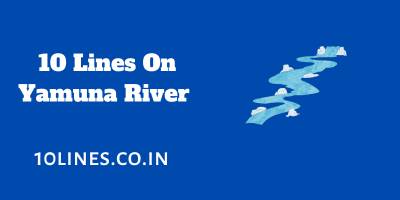10 Lines On Yamuna River Are you looking for a ten-line analysis essay on the Holy River Yamuna? This article offers three alternative 10-line Yamuna River essays for different age groups. These are three essays for children, high school students, and college students. Read all three sets to understand more about the Yamuna River.

10 Lines On Yamuna River For Children And Students
Here you can get a lot of information about the Yamuna River, including its origin, length, tributary rivers, importance in local culture, and so on.
Yamuna is one of the most sacred rivers in India after the river Ganges. It rises in the glaciers of the Himalayas and falls into the Ganges on the famous spot Triveni Sangam. It is the fourth largest among Indian rivers and passes through the different Indian states.
Continue reading to learn more about the Yamuna River.
Set 1] 10 Lines On Yamuna River For Children:
1] Yamuna is an Indian river and a significant tributary of the Ganga.
2] The river begins at Yamunotri, 3,293 meters above sea level in the Garhwal Himalayas.
3] The river passes through Uttar Pradesh, Madhya Pradesh, Haryana, Rajasthan, Himachal Pradesh, and Delhi.
4] The Yamuna River travels approximately 855 kilometers from its source to the Ganga River.
5] The basin area of the holy river is around 366,223 km2, which is approximately 40% of the basin area of the Ganga.
6] On the banks of the sacred Yamuna River lie well-known cities such as Yamuna Nagar, Mathura, Kairana, Baghpat, New Delhi, and Noida.
7] The river flows into the Ganga near the Triveni Sangam in Prayagraj.
8] Some of the Yamuna river’s tributaries include Giri, Baghain, Chambal, Hindon, Tons, Ken, and others.
9] The river Yamuna is also known as the ‘Jumna’.
10] The river is recognized as Delhi’s lifeline.
Set 2: 10 Lines On Yamuna River For School Students:
1] Yamuna, India’s fourth largest river, is primarily found in the northern Indian states of Uttarakhand and Uttar Pradesh.
2] The river Yamuna begins and ends in the same country.
3] Dwarkadhish is a well-known temple on the banks of the Yamuna River.
4] In Hinduism, the Yamuna is regarded as the daughter of the sun and Yama’s sister (God of death).
5] Yamuna Pushkaram is a popular festival celebrated on the banks of the river that happens once in 12 years.
6] In terms of length, the Yamuna River ranks fourth after the Ganga, Godavari, and Krishna.
7] Among the hydropower plants that rely on the Yamuna River are Chibro, Khodri, Giri Bata, and Madhikera.
8] The river flows through some of India’s most famous towns, including Agra, Delhi, Mathura, and Prayagraj.
9] River water is utilized for agriculture, drinking, industrial uses, and so on.
10] Some of India’s most important attractions, such as the Taj Mahal and the Agra Fort, are located on the banks of the Yamuna River.
Set 3: 10 Lines On Yamuna River For College Students:
1] The sacred Yamuna River is one of India’s most revered rivers.
2] The river rises in the Himalayas near Yamunotri and flows south to meet the Ganga at Triveni Sangam in Prayagraj.
3] Millions of people who live on the banks of the Yamuna rely on the river for their daily necessities and it meets around 70% of Delhi’s water demands.
4] It is one of the rivers where India’s most famous Hindu pilgrimage, the Kumbh mela, takes place once every 12 years.
5] The Yamuna is the Ganga’s longest and second-largest tributary, with an average flow rate of 2,950 m3/s.
6] The Yamuna River generated a particularly fertile and alluvial area when it met the Ganges.
7] Due to industrial effluents, municipal trash, and other factors, the river Yamuna is one of India’s most polluted rivers.
8] India’s national and state governments are making significant efforts to clean up the Yamuna River.
9] During the festival seasons, a large number of people take a holy dip in the river water. The river is also used by people for mass bathing for religious purposes.
10] On the banks of the Yamuna River, there are numerous religious temples.
Readers, thank you for taking the time to read about the Yamuna River. We hope you found the information above useful and enjoyable to read. We attempted to give this information on the Yamuna River in a simple and easy-to-remember style. Let us know how this post aided you in the comments area.